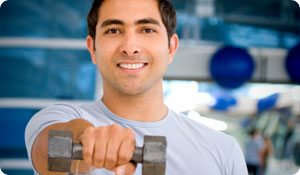
If you know the physiology of exercise, it's no wonder you feel pain when you work out. Every time you work a muscle, tiny holes are made in the tissue-the harder you push them, the bigger the holes. After your workout when you're at rest, your body then goes through a healing period, fixing the holes, and making them stronger. This is the muscle building process.
So it may seem that putting your body through such torture would yield more injuries and more pain; however, the usual soreness and dull aches you sense are typically normal. That said, there are a few pains that, if experienced while working out, you should never ignore.
Chest Pain
Whether you're going for a jog or lifting weights, your heart rate will raise. In some cases, when you're pushing yourself especially hard, it may feel like your heart is ready to burst out of your chest. But if you're experiencing real heart pain when you exercise,meaning a significant abnormal sensation in the middle of your chest--you need to take action.
In most cases, true heart pain is caused by atherosclerosis, a condition characterized by fatty plaque build up in your coronary arteries. These deposits hinder the delivery of blood and oxygen to your heart. When your heart rate rises and blood flow to your heart is increased, the blockage caused by atherosclerosis manifests itself as pain in the middle of your chest.
Atherosclerosis can lead to heart attack, or in severe cases, heart failure. If you're sensing discomfort in or around the chest area when you work out, take action and visit your physician.
Abdominal/Pelvic Pain
For the most part, abdominal discomfort during exercise is simply caused by indigestion. If you feel gassy at the gym, think about reassessing your pre-workout meal. However, if you're experiencing significant pain in the lower abdomen or pelvic region, you may be suffering from an inguinal or "sports" hernia.
Inguinal hernias affect approximately 27 percent of the male population. Both inguinal and sports hernias are caused by the weakening of the abdominal tissue. In the case of inguinal hernias, the muscles weaken to a point where a pouch, the hernia, is felt. For the most part, they are easy to spot. If you're experiencing pain in your lower abdomen and notice a slight bump or pouch, then you most likely are suffering from an inguinal hernia.
A sports hernia, however, is less obvious. In the case of a sports hernia, the problem is due to a weakening in the same abdominal wall muscles, but there is no noticeable hernia. This makes diagnosing a sports hernia exceedingly difficult. The symptoms, however, include pain in the lower abdomen or groin area, and/or pain in the testicles. Athletic motions such as running, cutting, or jumping will exacerbate the pain.
Both conditions require surgery to treat. If you suspect either an inguinal or a sports hernia, be sure to have your doctor take a look. An untreated hernia could result in extended periods of severe pain. In rare instances, not treating a hernia could give rise to intestinal inflammation, strangulation, hemorrhage, or obstruction.





